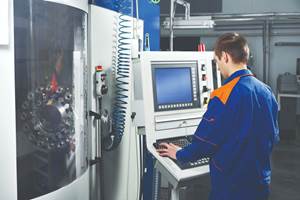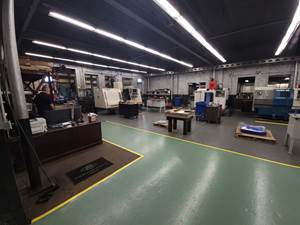Laser Calibration Analyzes Accuracy Of The Entire Machine Tool
As customers require higher accuracy and compliance with quality initiatives, such as ISO 9000, TQM and predictive maintenance, machine tool accuracy checks have become more important for job shops.
As customers require higher accuracy and compliance with quality initiatives, such as ISO 9000, TQM and predictive maintenance, machine tool accuracy checks have become more important for job shops. But checking accuracy is one of the more difficult problems to address, because it is affected by much more than the castings, CNC control and way systems. For example, servoloop feedback, acceleration and deceleration, complexity of the program, tooling and materials all can affect accuracy.
Since machine tool builders routinely address accuracy issues, what better source for machine tool calibration insight could there be? For example, Milltronics Manufacturing Company started manufacturing CNC controls and later began building machine tools. Today, the company makes machining centers and three-axis milling machines in its 100,000 square foot facility in Waconia, Minnesota. Recently, Milltronics was looking for a way to improve its calibration. It decided to outfit its field service department with the MCV-500 Laser Calibration System, made by Optodyne, Inc. (Compton, California), because of its high mobility. The company realized a number of additional benefits.
“Customers have a higher level of trust and confidence in laser calibration systems,” says Tim Rashleger, sales manager at Milltronics. “The problems with sorting out an accuracy concern include lack of customer confidence in measurement bars and ground bars. Is the bar square on the table, is it expanding and is the indicator good?”
The MCV-500 Laser Calibration System checks for squareness, linear displacement, table pitch and straightness with a stabilized laser and features a stability check of better than 0.1 PPM, accuracy of 1.0 PPM and resolution up to 1 microinch. Also available is automatic compensation for environmental factors that can cause thermal expansion, such as barometric pressure, air temperature and material temperature. The MCV-500 is calibrated and traceable to NIST (National Institute of Standards and Technology), and software analysis supports NMTBA, VDI, ISO and ASME B5.54 standards. Data collection software is supported by Windows and can be operated from most notebook computers for ease of use.
“Our field tech support staff travels to the machine when there is an accuracy issue, so mobility and setup times become very crucial,” says Mark Holden, service manager at Milltronics. “You have to get in and get the problem taken care of for the customer. We were attracted to the MCV-500 because its small size provides mobility, unlike other systems.”
The MCV-500 utilizes a Laser Doppler Displacement Meter (LDDM), which is based on microwave radar and laser technology. The LDDM utilizes electro-optics, optical heterodyne techniques and phase-demodulators to obtain position information from a movable corner-cube called a retroreflector. The laser beam is reflected off of the retroreflector, and the beam is detected and processed for displacement information, which is used to determine position accuracy of the CNC servoloop.
“Not all laser calibration systems are the same,” says Craig Foster, quality control manager at Milltronics. “We found the MCV-500 has fewer components to align and can be set up in 20 percent of the time other systems take.”
The MCV-500 requires only two optics, a laser head and a retroreflector, while laser interferometer systems require three optics, one of which, the laser head, must be mounted on a tripod outside of the machine tool. The MCV-500 laser head assembly requires only a small percentage of the return beam, which makes alignment quick. In addition, the laser head and the retroreflector conveniently mount on the machine tool, so the enclosure, fixtures and tools usually do not need to be removed, which decreases machine tool setup and down time. In addition, by mounting the optical components on the machine tool, accuracy and reliability are increased. Since the MCV-500 has only two components, alignment is a lot easier and faster than systems with three components that require a tripod-mounted laser head.
“Optodyne’s ASCII data format allows us to compile data so it can be easily downloaded into our CNC control through a Windows compatible notebook computer and an RS-232 port,” says Mr. Foster. “We developed the capability that enables our controls to take the information directly from the MCV-500 to compensate for errors, without manually writing a comp table.”
Because the MCV-500 software automatically collects data, the potential for human error is reduced, and the results have a high degree of reliability. The software features online help and easy commands, which allow different screens to be viewed, such as a Data Collection Screen that displays two numbers—the LDDM position and the target position. A Setup Screen displays measurement options that include which axes and automatic or manual data collection, and so on.
“The Optodyne system allows us to check acceleration and deceleration and whether or not we’re hitting our target point right on the money or under or overshooting,” says Mr. Foster.
Typically, acceleration is checked at the drive or motor level, which tells the engineer what the machine is doing. If variables, such as the ballscrew, table and the inertia of the table aren’t addressed, then there’s not an accurate assessment of what the machine is doing at the tool.
“The MCV-500 enables us to look at all the components that affect position, not just the control or just the servoloop,” says Mr. Foster. “We can make corrections to both software and mechanical aspects of the machine.”
“Customers have become much more technically savvy; they want technical factory expertise,” says Mr. Foster. “The MCV-500 is one of the tools that brings factory expertise into the customer’s facility.” MMS
Related Content
When Handing Down the Family Machine Shop is as Complex as a Swiss-Turned Part
The transition into Swiss-type machining at Deking Screw Products required more than just a shift in production operations. It required a new mindset and a new way of running the family-owned business. Hardest of all, it required that one generation let go, and allow a new one to step in.
Read MoreUnderstanding CNC Machine Accuracy and Repeatability
Properly evaluating machine tool capability requires understanding how the both user and the builder can influence precision.
Read MoreHow this Job Shop Grew Capacity Without Expanding Footprint
This shop relies on digital solutions to grow their manufacturing business. With this approach, W.A. Pfeiffer has achieved seamless end-to-end connectivity, shorter lead times and increased throughput.
Read MoreFrom Tradition to Transformation: Century-Old Manual Machine Shop Adds CNCs
After 122 years of working with manual mills and lathes, this fifth-generation shop acquired assets of a local CNC machining business and hired the owner. Here’s how it’s going a year later.
Read MoreRead Next
The Cut Scene: The Finer Details of Large-Format Machining
Small details and features can have an outsized impact on large parts, such as Barbco’s collapsible utility drill head.
Read More3 Mistakes That Cause CNC Programs to Fail
Despite enhancements to manufacturing technology, there are still issues today that can cause programs to fail. These failures can cause lost time, scrapped parts, damaged machines and even injured operators.
Read More















.png;maxWidth=300;quality=90)









